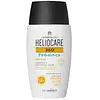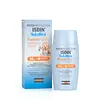What's inside
What's inside
 Key Ingredients
Key Ingredients

 Benefits
Benefits

 Concerns
Concerns

 Ingredients Side-by-side
Ingredients Side-by-side

Water
Skin ConditioningC12-15 Alkyl Benzoate
AntimicrobialDimethicone
EmollientIsododecane
EmollientTitanium Dioxide
Cosmetic ColorantZinc Oxide
Cosmetic ColorantButyloctyl Salicylate
Skin ConditioningSodium Potassium Aluminum Silicate
Niacinamide
SmoothingAlumina
AbrasiveStyrene/Acrylates Copolymer
Phenethyl Benzoate
EmollientPEG-9 Polydimethylsiloxyethyl Dimethicone
EmulsifyingPolypodium Leucotomos Leaf Extract
Skin ProtectingPhysalis Angulata Extract
Skin ProtectingMelanin
Skin ProtectingPlankton Extract
Skin Conditioning3-O-Ethyl Ascorbic Acid
Skin ConditioningOxothiazolidine
Skin ProtectingTocopheryl Acetate
AntioxidantHydrogen Dimethicone
Phenylpropanol
MaskingPolyhydroxystearic Acid
EmulsifyingMagnesium Sulfate
Dimethicone/PEG-10/15 Crosspolymer
Propylene Glycol
HumectantCaprylyl Glycol
EmollientSilica
AbrasivePropanediol
SolventTriethoxycaprylylsilane
Caprylic/Capric Triglyceride
MaskingTocopherol
AntioxidantButylene Glycol
HumectantDipropylene Glycol
HumectantSodium Citrate
BufferingDisteardimonium Hectorite
StabilisingPropylene Carbonate
SolventLecithin
EmollientPhenoxyethanol
PreservativeSodium Benzoate
MaskingWater, C12-15 Alkyl Benzoate, Dimethicone, Isododecane, Titanium Dioxide, Zinc Oxide, Butyloctyl Salicylate, Sodium Potassium Aluminum Silicate, Niacinamide, Alumina, Styrene/Acrylates Copolymer, Phenethyl Benzoate, PEG-9 Polydimethylsiloxyethyl Dimethicone, Polypodium Leucotomos Leaf Extract, Physalis Angulata Extract, Melanin, Plankton Extract, 3-O-Ethyl Ascorbic Acid, Oxothiazolidine, Tocopheryl Acetate, Hydrogen Dimethicone, Phenylpropanol, Polyhydroxystearic Acid, Magnesium Sulfate, Dimethicone/PEG-10/15 Crosspolymer, Propylene Glycol, Caprylyl Glycol, Silica, Propanediol, Triethoxycaprylylsilane, Caprylic/Capric Triglyceride, Tocopherol, Butylene Glycol, Dipropylene Glycol, Sodium Citrate, Disteardimonium Hectorite, Propylene Carbonate, Lecithin, Phenoxyethanol, Sodium Benzoate
Water
Skin ConditioningDicaprylyl Carbonate
EmollientDiethylhexyl Carbonate
EmollientCyclopentasiloxane
EmollientDibutyl Adipate
EmollientTitanium Dioxide
Cosmetic ColorantZinc Oxide
Cosmetic ColorantAlcohol Denat.
AntimicrobialCyclohexasiloxane
EmollientButylene Glycol
HumectantPEG-30 Dipolyhydroxystearate
EmulsifyingNylon-12
Dimethicone
EmollientPEG-10 Dimethicone
Skin ConditioningSodium Chloride
MaskingSilica
AbrasivePhenoxyethanol
PreservativeDisteardimonium Hectorite
StabilisingAllantoin
Skin ConditioningGlyceryl Stearate
EmollientTocopheryl Acetate
AntioxidantTriethoxycaprylylsilane
Disodium EDTA
Sodium Hyaluronate
HumectantEthylhexylglycerin
Skin ConditioningPEG-8
HumectantTocopherol
AntioxidantAscorbyl Palmitate
AntioxidantAscorbic Acid
AntioxidantCitric Acid
BufferingWater, Dicaprylyl Carbonate, Diethylhexyl Carbonate, Cyclopentasiloxane, Dibutyl Adipate, Titanium Dioxide, Zinc Oxide, Alcohol Denat., Cyclohexasiloxane, Butylene Glycol, PEG-30 Dipolyhydroxystearate, Nylon-12, Dimethicone, PEG-10 Dimethicone, Sodium Chloride, Silica, Phenoxyethanol, Disteardimonium Hectorite, Allantoin, Glyceryl Stearate, Tocopheryl Acetate, Triethoxycaprylylsilane, Disodium EDTA, Sodium Hyaluronate, Ethylhexylglycerin, PEG-8, Tocopherol, Ascorbyl Palmitate, Ascorbic Acid, Citric Acid
 Reviews
Reviews

Ingredients Explained
These ingredients are found in both products.
Ingredients higher up in an ingredient list are typically present in a larger amount.
Butylene Glycol (or BG) is used within cosmetic products for a few different reasons:
Overall, Butylene Glycol is a safe and well-rounded ingredient that works well with other ingredients.
Though this ingredient works well with most skin types, some people with sensitive skin may experience a reaction such as allergic rashes, closed comedones, or itchiness.
Learn more about Butylene GlycolDimethicone is a type of synthetic silicone created from natural materials such as quartz.
What it does:
Dimethicone comes in different viscosities:
Depending on the viscosity, dimethicone has different properties.
Ingredients lists don't always show which type is used, so we recommend reaching out to the brand if you have questions about the viscosity.
This ingredient is unlikely to cause irritation because it does not get absorbed into skin. However, people with silicone allergies should be careful about using this ingredient.
Note: Dimethicone may contribute to pilling. This is because it is not oil or water soluble, so pilling may occur when layered with products. When mixed with heavy oils in a formula, the outcome is also quite greasy.
Learn more about DimethiconeDisteardimonium Hectorite comes from the clay mineral named hectorite. It is used to add thickness to a product.
It can also help stabilize a product by helping to disperse other ingredients.
Hectorite is a rare, white clay mineral.
Learn more about Disteardimonium HectoritePhenoxyethanol is a preservative that has germicide, antimicrobial, and aromatic properties. Studies show that phenoxyethanol can prevent microbial growth. By itself, it has a scent that is similar to that of a rose.
It's often used in formulations along with Caprylyl Glycol to preserve the shelf life of products.
Silica, also known as silicon dioxide, is a naturally occurring mineral. It is used as a fine, spherical, and porous powder in cosmetics.
Though it has exfoliant properties, the function of silica varies depending on the product.
The unique structure of silica enhances the spreadability and adds smoothness, making it a great texture enhancer.
It is also used as an active carrier, emulsifier, and mattifier due to its ability to absorb excess oil.
In some products, tiny microneedles called spicules are made from silica or hydrolyzed sponge. When you rub them in, they lightly polish away dead skin layers and enhance the penetration of active ingredients.
Learn more about SilicaTitanium dioxide is a mineral UV filter widely used in sunscreens and cosmetics.
It is one of only two UV filters officially classified as “mineral” by regulatory agencies, the other being zinc oxide.
Titanium dioxide provides broad-spectrum protection mostly in the UVB and UVAII range, with some protection in the UVAI range.
While its UVA protection isn’t as strong as zinc oxide’s, the difference is minor.
A common myth is that mineral UV filters reflect UV light. However, modern research shows titanium dioxide absorbs UV radiation like chemical filters (~95% absorption & 5% reflection).
Thanks to its non-irritating nature, titanium dioxide is suitable for sensitive, acne-prone, or redness-prone skin. It is unlikely to cause "eye sting" like other sunscreen ingredients.
A major drawback of this ingredient is its white cast and thick texture. This is why mineral sunscreens often leave a white cast and are less cosmetically elegant than chemical/hybrid sunscreens.
To improve white cast and spreadability, micronized or nano-sized titanium dioxide is often used.
There are ongoing concerns surrounding nano-titanium oxide's impact on marine ecosystems.
There is no conclusive evidence that any form of titanium oxide (or any other sunscreen ingredients) will cause harm to marine ecosystems or coral reefs. The science is still developing but many consumers are keeping a close eye on this issue.
Please note, many destinations have reef-safety sunscreen rules. For instance, the U.S. Virgin Islands advises all visitors to use non-nano mineral sunscreens.
Nano mineral sunscreens once raised safety concerns about absorption into skin.
Extensive research has shown that they do not penetrate healthy or damaged skin; they remain safely on the surface and the top layer of dead skin (stratum corneum).
You'll likely find titanium dioxide bundled with alumina, silica, or dimethicone. These ingredients help make titanium dioxide highly photostable; this prevents it from interacting with other formula components under UV light.
Learn more about Titanium DioxideTocopherol (also known as Vitamin E) is a common antioxidant used to help protect the skin from free-radicals and strengthen the skin barrier. It's also fat soluble - this means our skin is great at absorbing it.
Vitamin E also helps keep your natural skin lipids healthy. Your lipid skin barrier naturally consists of lipids, ceramides, and fatty acids. Vitamin E offers extra protection for your skin’s lipid barrier, keeping your skin healthy and nourished.
Another benefit is a bit of UV protection. Vitamin E helps reduce the damage caused by UVB rays. (It should not replace your sunscreen). Combining it with Vitamin C can decrease sunburned cells and hyperpigmentation after UV exposure.
You might have noticed Vitamin E + C often paired together. This is because it is great at stabilizing Vitamin C. Using the two together helps increase the effectiveness of both ingredients.
There are often claims that Vitamin E can reduce/prevent scarring, but these claims haven't been confirmed by scientific research.
Learn more about TocopherolTocopheryl Acetate is AKA Vitamin E. It is an antioxidant and protects your skin from free radicals. Free radicals damage the skin by breaking down collagen.
One study found using Tocopheryl Acetate with Vitamin C decreased the number of sunburned cells.
Tocopheryl Acetate is commonly found in both skincare and dietary supplements.
Learn more about Tocopheryl AcetateTriethoxycaprylylsilane is a silicone used to bind and stabilize ingredients.
As an emulsifier, it helps prevent ingredients from separating. This can help elongate the shelf life of products.
Triethoxycaprylylsilane is often used to coat mineral sunscreens ingredients to help give a better feel. It also helps reduce oxidative stress in sunscreens.
Learn more about TriethoxycaprylylsilaneWater. It's the most common cosmetic ingredient of all. You'll usually see it at the top of ingredient lists, meaning that it makes up the largest part of the product.
So why is it so popular? Water most often acts as a solvent - this means that it helps dissolve other ingredients into the formulation.
You'll also recognize water as that liquid we all need to stay alive. If you see this, drink a glass of water. Stay hydrated!
Learn more about WaterZinc Oxide is a mineral broad-spectrum UV filter; it is the broadest UVA and UVB reflector approved by the FDA. It also has skin protectant and skin soothing properties.
Zinc oxide is one of the most effective broad-spectrum UV filters. It protects against UVB, UVAII, and UVAI. In comparison to its counterpart titanium dioxide, zinc oxide provides uniform and extended UVA protection.
Another great benefit? This ingredient is highly photostable so it won't degrade easily under sunlight.
A common myth is that mineral UV filters are widely believed to primarily reflect UV light.
However, modern research shows titanium dioxide absorbs UV radiation like chemical filters (~95% absorption & 5% reflection).
Zinc oxide has great skin soothing properties so you'll likely find this in sunscreens formulated for sensitive skin or babies/children. It is unlikely to cause "eye sting" like other sunscreen ingredients.
Regulatory agencies consider zinc oxide to be non-toxic and safe. It has also been shown to not penetrate the skin.
Unfortunately, this ingredient does leave a visible white cast. This is why mineral sunscreens are often less cosmetically elegant than chemical or hybrid ones.
In cosmetics, zinc oxide can be found in both non-nano and nano-sized forms. The nano version is used to reduce white cast and improve the texture of sunscreen formulas.
There are ongoing concerns surrounding nano-zinc oxide's impact on marine ecosystems and whether it can be absorbed into skin.
Regarding marine ecosystems and coral reefs, there is no conclusive evidence that any form of zinc oxide (or any other sunscreen ingredients) will cause harm. The science is still developing but many consumers are keeping a close eye on this issue.
Please note, many destinations have reef-safety sunscreen rules. For instance, the U.S. Virgin Islands advises all visitors to use non-nano mineral sunscreens.
There has also been some stir about whether micronized or nano zinc oxide has potential photoxicity and absorption through the skin/lungs.
An in-vitro (done in a test tube or petri dish) study demonstrated micronized zinc oxide to have potential phototoxicity. There's no need to fret; the EU Commission's Scientific Committee on Consumer Safety has stated, "The relevance of these findings needs to be clarified by appropriate investigations in vivo." Or in other words, further studies done on living organisms are needed to prove this.
Current research shows zinc oxide nanoparticles do not penetrate intact or sunburned skin. They either remain on the surface or in the outermost layer of dead skin (stratum corneum).
Zinc oxide is one of only two classified mineral UV filters with titanium dioxide being the other one.
Fun fact: Zinc has been used throughout history as an ingredient in paint and medicine. An Indian text from 500BC is believed to list zinc oxide as a salve for open wound. The Ancient Greek physician Dioscorides has also mentioned the use of zinc as an ointment in 1AD.
Learn more about Zinc Oxide